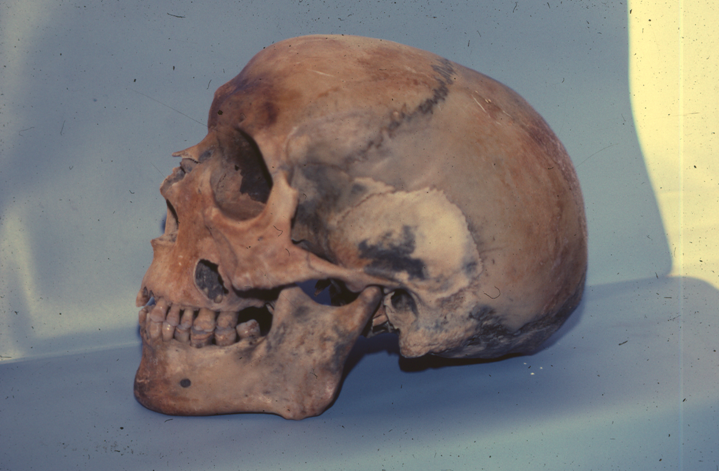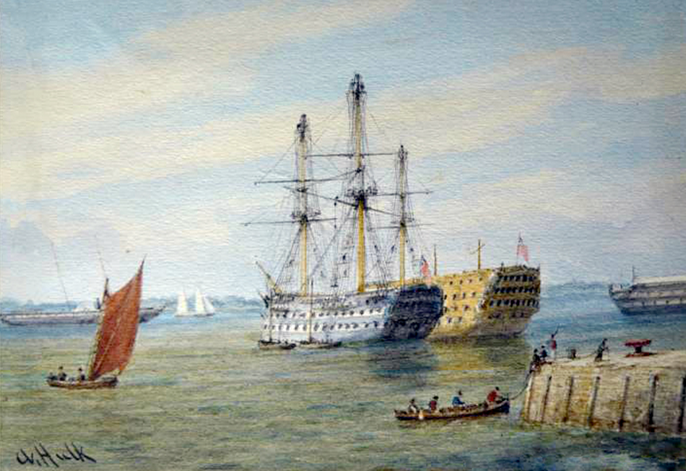The story goes that one Sunday morning in the 1980s an embarrassed fisherman walked into Torpoint Police Station with a bulging Tesco carrier bag. In it was a mud-encrusted human skull, which he had found while digging for bait in St John’s lake. Overlooking the fact that such digging is forbidden, a discussion took place as to whether the exhibit should be treated as lost property or evidence of a murder.
The cleaned up skull ended up in our department. The Coroner’s Office needed to know whether the skull was from a recently deceased person, or possibly from a member of the crew of an RFA Coal Carrier which had sunk during the 1940s.

The skull is dolichocephalic, with a nasal lip, suggesting Caucasian origin. This shape can also be of Negro anthropology, but we were unable to determine this, as it requires comparison with tables to which we had no access. Eyebrow ridges, mastoid process, and masseter attachment indicate that the individual was male.
The teeth were mostly in good condition, except for the upper left first molar which was decayed. The lower third molar teeth were fully erupted, and their root formation appeared to be complete (by radiographic examination), suggesting the individual was at least 20 years old. There was significant wear on the surfaces of all the teeth, including the third molars, which suggests several more years of age.
There was a great deal of hard calculus deposited on the inner surfaces of the teeth on the left side only. This is probably because the man had been chewing only on the other side for some considerable time, one assumes because of the pain from the decayed tooth on the upper left. This tooth had been abscessed for some considerable time, with the abscess cavity displacing the sinus cavity above, and expanding the lateral bony wall until it (presumably) discharged out on to the surface of the cheek.
So the man had a tooth that was so painful he couldn’t eat properly, and a very visible swollen pustule on his cheek, for some considerable time. The very simplest of dental treatment - an extraction - would have solved his problem, but this was not done.
Had he been a member of the RFA in the 1940s he would have been unlikely to be allowed to let the tooth get into that state. If it had been like that on his joining, it would have been extracted forthwith. If he had been living on the average diet of the 1930s, he would probably have had more decay, which would have been treated.
Determining the age of a person from the wear on their teeth is a very risky business, because it is very dependent on diet. Modern ‘western’ individuals can reach old age with no perceptible wear on their teeth. Rural Asian, or African people often show wear quite early in life, while their urban counterparts do not.
A more reliable measurement is to determine the amount of pulp regression that has taken place, as there has been a little research correlating age with this recession. It occurs to me that I should try this some time.
But in the 1980s, we decided that the wear was pretty severe for the age, and may have meant that the man had lived in the era of stone ground flour - before about 1820. This would also account for his lack of dentistry. Or would it? Even before 1820, there were people that could take a tooth out. Our man would have to be very poor, or extremely unfortunate, to be unable to get some help. And how did he end up in St Johns Lake?
Here we resorted very quickly to to conjecture, imagination and faulty research. Between about 1790 and 1812, civilian prisoners and prisoners of war were held in hulks like these, moored in the Hamoaze. One of our less reliable informants told us that St Johns Lake was the site of one of these hulks, and burials from this vessel accounted for the area being known as Dead Man’s Lake, for the frequency of cannon balls being found there, and for the ban on digging bait.

Really interesting, but so far I have learned that Dead Man’s Bay is on the other side of the Tamar, that no hulk was moored anywhere in St John’s Lake, bait digging is controlled, not forbidden, since the area is a SSSI, and the cannonballs are remains from gun exercise. Since HMS Raleigh overlooks the area, it was suggested that this was the source of the gunfire. But the kind of balls that are found in the lake predate HMS Raleigh, which was only started in the 1940s. It seems more likely that the guns were fired into the bay from a vessel moored outside.
And there are many other reasons that a body might end up in the Tamar before 1820. But a prisoner of war, held on a hulk near the 18th Century site of the Naval Dockyard is certainly a candidate. He would have no medical attention and if he died aboard, he would probably have been dropped overboard in a shroud weighted with something (but I doubt a cannonball). Even before the shroud and body broke up, the whole thing might have travelled on the tide. The currents in that area are very strong. The bodies of people that do not survive a jump from the Tamar suspension bridge, are often recovered from the strand at Bere Alston, a considerable distance upstream from the bridge. In addition to the fierce currents, in the early 1800s, the boat traffic in that area would have been considerable, and a body going into the water at North Corner soon after high tide, might well snag up in the bay opposite - St John’s lake, as the tide fell.